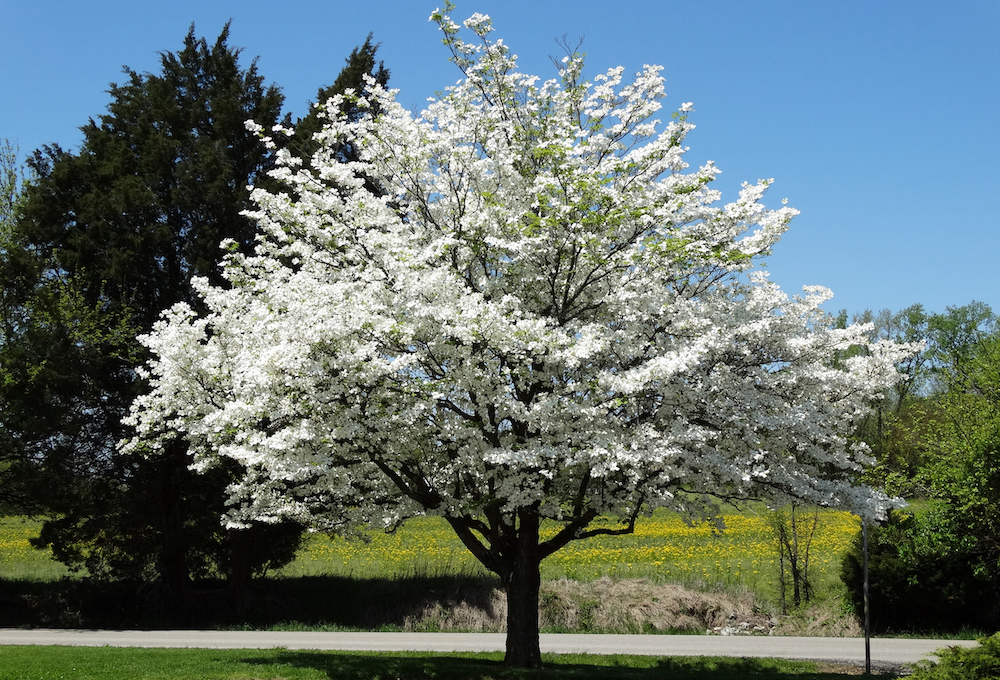Among the trees that flower in the springtime, my favorite is the dogwood, prompting my husband and I to plant one in our backyard a few years ago. The first spring its branches yielded only three blossoms, five during the second year; but this year, much to our delight, every branch is bursting with flower buds.
The dogwood has long been associated with Jesus’ death on the cross. With its blooming typically coinciding with the final weeks of Lent and/or Easter, it serves as nature’s reminder of the price the Son of God paid for our salvation.
Legend has it that the cross to which Jesus was nailed was cut from a dogwood tree, for in its earliest life, dogwoods were as large as oak trees. However, because of the role it played in the death of our Lord, it was blessed and cursed. No longer counted among the largest trees, it was doomed to live out its days on Earth as a tree that would remain relatively small in stature as a reminder of the humility of the God man whose body it bore.
Another version of the legend purports that Jesus, sensing the tree’s anguish over the role it was forced to play in his death, blessed the tree by gifting it with the potential to bear blossoms that would burst forth every year during the season that celebrates the Paschal Mystery.
So it happened that dogwood trees remain a symbol of purity and rebirth now and until the end of time. Suffice to say, the flowers that grace the branches of these trees are no ordinary blossoms.
The flower, consisting of four petals, form a cross, which is the symbol of our salvation. From its rather rough center, which represents the crown of thorns that adorned the sacred head of Jesus, issues forth red streaks that remind us of the blood that Jesus shed on our behalf.
Since not all dogwood trees are white, the pink flora of some represents the gentleness, affection and maternal heart of God. However, regardless of the color of the flower and despite its gentle appearance, blossoms that grace the dogwood are actually quite sturdy. Not only are they able to withstand the unexpected cold snaps that frequently accompany spring, but they adhere to their branches with surprising tenacity when assaulted from every direction by March winds that can be relentless at times.
Given their beauty and symbolism, it’s little wonder that dogwood trees are used to adorn yards and gardens, but they are also seen thriving in wooded areas where their unlikely presence adds a taming ambiance to even the most rugged terrains.
Although the lifespan of the tree’s flower is relatively short, it reminds us that no matter how appealing the many joys and pleasures of Earth seem, they, too, will pass. While the dogwood tree doesn’t bear the kind of fruit that feeds our body, it certainly provides abundant food for thought, directing hearts and minds toward spiritual fruit that is ours for the taking.
As we enter one more Easter season, signs of new life and rebirth are everywhere, as a sign that resurrection is an ongoing reality. During his life on Earth, Jesus often used nature as a means to illustrate the Kingdom of God that is forever recreating us anew.
Opportunities to see God everywhere are endless, but unless we take the time to ponder the glories of God that surround us, we remain victims of a world that directs our attention to only that which is passing or worse focuses mostly on what is evil.
With the weather warming and sunshine beckoning, we do ourselves and the people with whom we live a great service by spending more time outdoors, identifying ways that nature reminds us of the many ways that Jesus used nature to teach us the ways of God.
The fact that it took three years before our dogwood tree provided an abundance of blossoms reminds me of the parable that Jesus told about the fig tree that failed to bear fruit because the soil needed to be tilled, fertilized and watered with tender loving care.
The same thing holds true for us and the garden of our soul. If we’ve failed to do all that was needed to conform our life and will to the will of God, we are reminded that now is the time.
What better time than spring and the Easter season to nurture the seeds that were planted at baptism so that we can become the glorious persons that God created us to be so that we will blossom for all eternity.

